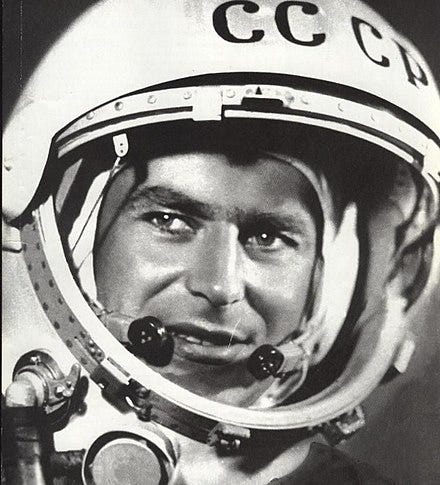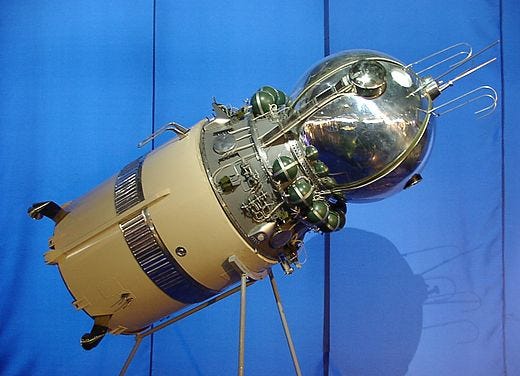Vostok-2/Oryol (Eagle)
August 7, 1961, 12:57 am
Crew: Gherman Titov
Orbits: 17
Duration: 1 day, 1 hour, 18 minutes
Once again, the Soviets pushed ahead. 25-year-old Gherman Titov was launched on August 7th, 1961 and spent 25 hours in space, orbiting the Earth 17 times. The flight was nearly a complete success, but Titov was the first to report space sickness, a condition that continues to affect some astronauts and cosmonauts.
Spurred on by this development, NASA announced on August 18th that the next American to fly, John Glenn, would ride an Atlas booster into orbit for the first time.
The Vostok Spacecraft
The Soviet Vostok spacecraft was an off-shoot of their Zenit spy satellite program. It consisted of two modules. The spherical descent module was only 7.5 feet (2.3m) in diameter and could carry a single cosmonaut. The instrument module contained the fuel and engine. After separating, the descent module couldn’t be controlled, meaning the entire surface had to be protected against the heat of re-entry. And the cosmonaut aboard would have to eject and parachute to safety.
The Soviet’s mounted the Vostok atop a modified R-7 ICBM.
The first test, of what the Soviets called Korabl-Sputnik 1, was conducted in May of 1960. The capsule orbited for several years before burning up during re-entry.
That was followed by six more tests carrying animals. The July 1960 launch of Vostok 1K-1 ended in an explosion just after launch that killed the two dogs aboard. Three weeks later, Korabl-Sputnik 2 carrying two dogs named Strelka and Belka was a success. One of Strelka’s puppies was later given to President Kennedy as a gift for his children.
A major setback for the Soviets was the explosion of an R-17 ICBM on the pad at the Baikonur launch facility on October 24, 1960. An Italian news agency reported the disaster in early December, citing unnamed sources that claimed more than a hundred people had been killed, including the Soviet Marshal in charge of the program. The Soviets themselves refused to admit the truth until 1989.
Testing of Vostok continued on December 1, 1960, with the launch of Korbl-Sputnik 3. The re-entry rockets didn’t fire long enough, which meant the spacecraft would not come down in Soviet territory. Mission controllers destroyed the spacecraft remotely, killing the two dogs aboard. Another test later that month failed to reach orbit, but the Vostok emergency escape system worked, and the spacecraft and its two canine passengers were safely recovered.
Two more unmanned tests, involving an upgraded Vostok capsule, would come in March of 1961 before the Soviets would risk putting a cosmonaut in the spacecraft.




